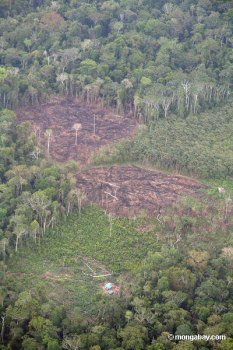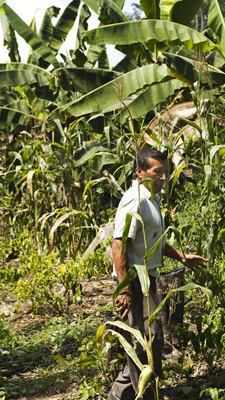
Anthropogenic forests in the Amazon
 The Amazonian forest is considered by many
environmentalists to be the Holy Grail of untouched biodiversity.
Or it was, until recently when scientists started uncovering evidence
that anywhere from 8% to 100% of the Amazon forest is anthropogenic.
The Amazonian forest is considered by many
environmentalists to be the Holy Grail of untouched biodiversity.
Or it was, until recently when scientists started uncovering evidence
that anywhere from 8% to 100% of the Amazon forest is anthropogenic.
Slash and burn agriculture is currently the norm in the Amazon basin,
and for a long time scientists assumed that slash and burn was the
ancient method of managing the forest. In this technique, farmers
hack a small opening out of the forest, burn the fallen trees, then
plant crops in the resultant rich bed of ash. After a few years,
trees begin to grow up in the gap, and farmers move on to cultivate a
new area. Although slash and burn is harmful to the air, the
method is vastly superior to trying to till the poor soil, which would
ruin the land in less than a decade. Instead, slash and burn
seems to be marginally sustainable.
 The slash and burn technique, though, is
clearly dependent on the European introduction of metal axes.
Using the Amazonians' indigenous stone axes, scientists estimate it
would have taken about three weeks to chop down a single tree.
Creating a forest gap in this scenario must have been a long term
undertaking with long term rewards.
The slash and burn technique, though, is
clearly dependent on the European introduction of metal axes.
Using the Amazonians' indigenous stone axes, scientists estimate it
would have taken about three weeks to chop down a single tree.
Creating a forest gap in this scenario must have been a long term
undertaking with long term rewards.
Scientists are now beginning to understand that slash and burn was
merely a method that Indians resorted to after disease devastated their
populations. Previously, the Amazonians did hack gaps out of the
forest canopy, but into each gap they planted small food crops like
manioc between carefully selected tree species. The trees were
the real crop, with the manioc being a secondary addition to their
diet. Over one hundred carefully bred tree species now dot the
Amazonian forest with their edible fruit. In essence, the
Amazonians were creating a forest
garden.
| This post is part of our American Indian Permaculture lunchtime
series.
Read all of the entries: |
Want more in-depth information? Browse through our books.
Or explore more posts by date or by subject.
About us: Anna Hess and Mark Hamilton spent over a decade living self-sufficiently in the mountains of Virginia before moving north to start over from scratch in the foothills of Ohio. They've experimented with permaculture, no-till gardening, trailersteading, home-based microbusinesses and much more, writing about their adventures in both blogs and books.
Want to be notified when new comments are posted on this page? Click on the RSS button after you add a comment to subscribe to the comment feed, or simply check the box beside "email replies to me" while writing your comment.
